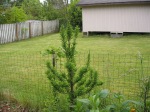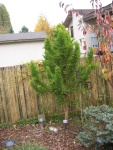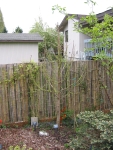
Of the few deciduous conifers that exist on this planet the Larch, or Larix, is probably the best known. There are some 11 species of it that grow from the Western US across the to the Atlantic seaboard and others that grow across Europe to Siberia and into the Himalayas and beyond to China and Japan. The one I’m showing you here is a form of the Japanese Larch, Larix kaempferi, called “Diana”. It’s a uniquely contorted form that bends and twists as it grows fast to a small tree of maybe 30 feet tall, in not much time, given that it’s grown 3 – 3 1/2 feet for the last two years I’ve had it and it’s still growing this year. It turns an amazing golden yellow in fall and can be seen from the house it’s so bright and clear in its color.
We won’t get much shade from this tree but its form and texture makes up for that quite well. This tree is in the Pinaceae, or Pine family, along with another of these deciduous conifers called the Pseudolarix, or Golden larch. It’s not a true larch but sure does look like one. Another great tree for fall color too. It goes bare in the fall too. So don’t be shocked when that lovely conifer you have in the front yard loses its leaves in the autumn. They’ll come back in the spring all feathery and bright green and new.

This tree in the Cypress family, or Cupressaceae, is well know in the south eastern parts of the US. It’s a variety of the Swamp Cypress that inhabits the swamps and wetlands of that area. This is the Taxodium distichum variety called a “Peve Minaret” for the developer of it in Holland. This is a dwarf form of the tree that will only grow to 10-20 feet tall, depending on which web site you read. I’ve only seen them get to 10 feet or so myself so we’ll see how it goes. The species tree grows to 100 -150 feet and is a valuable timber tree for commerce in its native habitat. The wood is known for its ability to withstand rot, as is true with many plants in the Cypress family. Not surprising, as it grows in water. It also develops “knees”, or roots that come up above the water line. Very cool…
This tree turns a lovely shade of orangish brown before it drops its needles in late fall. It’s late to leaf out in the spring too but the foliage is such a treat it’s well worth the wait. It’s one of my “pettable” trees because it’s so soft to the touch and easy to be around. Not prickly like so many conifers are. This tree is only 5 years old from a 5 ft tree, and it’s now over 10 feet tall and 7 feet across so it’s going to get much bigger in time. Maybe it’ll get to that 20 ft. mark. I’d like that, but since it only puts on about a foot each year, as is typical for many mid sized dwarf trees, it’ll take another 1o years or more to get there. I can wait…

This one is perhaps my favorite tree in the garden. Maybe. I have so many I love. This is a variety of the famous Dawn Redwood, or Metasequoia glyptostroboides. This variety is called “Miss Grace” and it’s a weeper that I had to train up to get it to its current height of 9 feet. Though it’s the smallest of the redwoods, the species will grow to over 200 feet tall in central China where it was just “discovered” in the early 1940’s. It was found in the fossil record just before then and was a surprise to be found living still in its native habitat. Its’s endangered there but its seeds have been sent to arboreta and nurseries all over the world. I planted my first one for my folks back in the early 70’s and I sure would like to see it now. It must be close to 80 feet by now I’d guess. Wow! I wish my folks had been able to keep that home…. ah well. But I digress…
The story of this particular cultivar, “Miss Grace”, is that the nurseryman that found it thought it was going to be a weeper and trail along the ground. But overnight the nursery workers tied it up to be a tree, so that’s what happened. I worked hard to get mine this tall but it wouldn’t stay put when I tried it to get it to 10 feet and it fell over about 2 months after I took off the training stakes. So now it weeps down all over itself. It’s another one of my “pettables” because it’s so incredibly soft to the touch. It turns a lovely shade of orangish brown, like the Taxodium, in the fall before it loses its needles. It grows a little slower than the other ones, at several inches a year, so it’ll be a treat to see how big it will get in time. I’m excited to see how it does.

Some folks will say I’m cheating with this one. Many people call this a conifer but it’s not really one. It’s clearly related it’s true, but it’s not truly a cone bearing tree like the confers. It’s a Gymnosperm tho like confers but is closer to the cycads (like Sago Palms…) than the conifers. But I’m including it anyway because so many people call it one, including the American Conifer Society. So I’m fine with putting it in this list. This is a Ginkgo biloba variety called “Jade Butterflies”. It’s a relatively small dwarf tree that will grow to the usual 10-20 feet tall, but so far it’s only gotten to about 8 feet in my garden. It’s grown about a foot a year tho so it won’t take it long to get to full size. The leaves look like small butterflies which is why it’s named for them. I can see it, but it’s a fanciful name, as so many botanical names are. That’s OK, it suits it.
This is a unique tree, being the only member of its family -the Ginkgoaceae – and has been around for over 270 million years in its current form. It’s called a living fossil and it truly is. Here in Washington State we have a State Park called the Ginkgo Petrified Forest and we visited it last year on a trip across the country. It was amazing to see the little leaves in the rocks and to imagine this tree being around way before the dinosaurs and humans by ages. It’s truly a piece of living history. There are some giant trees of this type growing all over the world now so it’s a treat to have a small one here in our small garden.
Well, that’s a tour of some deciduous conifers. The only one I didn’t mention was the Chinese Swamp Cypress (Glypstrobus – like the Metasequoia glyptostroboides which was named for it.) I feel privileged to have at least 3 ( maybe 4) of the 5 (maybe 6) deciduous conifers on the planet. I try to have a great variety of plants in this garden and now have over 200 different varieties or cultivars. It’s a lot of why we call this a Sanctuary, and sometimes a mini Botanical Garden. I purposefully sought out these deciduous conifers for their unique status and their wonderful habits of growth. I like it that they lose their leaves and die back each year. It’s nice to provide a different option for the garden instead of a dark heavy conifer. These are all much lighter feeling and the loss of leaves makes them look delicate and fine. Just my opinion, but I find them fascinating. I hope you do too.
No, they aren’t dead! 🙂
Steve
































